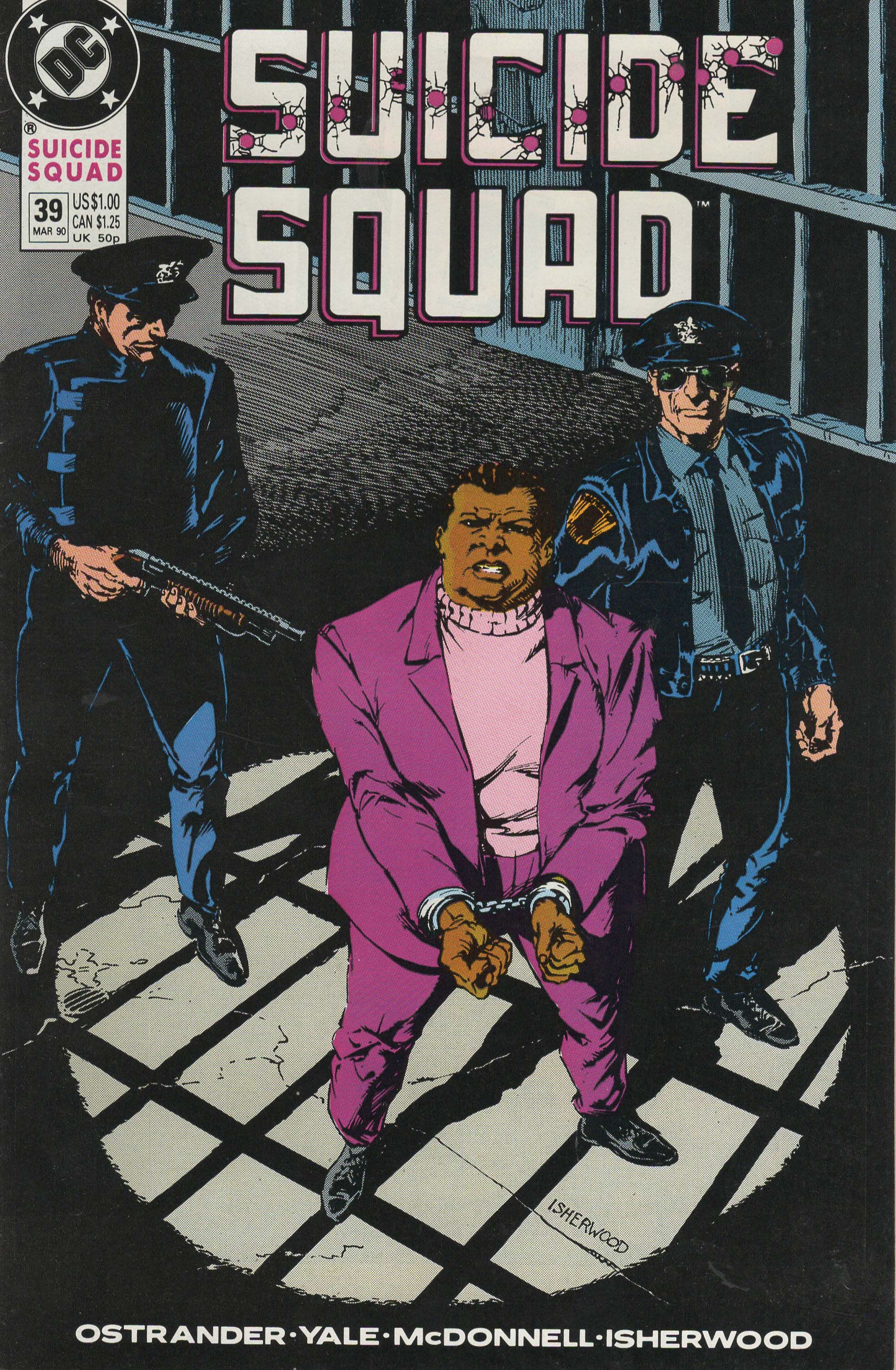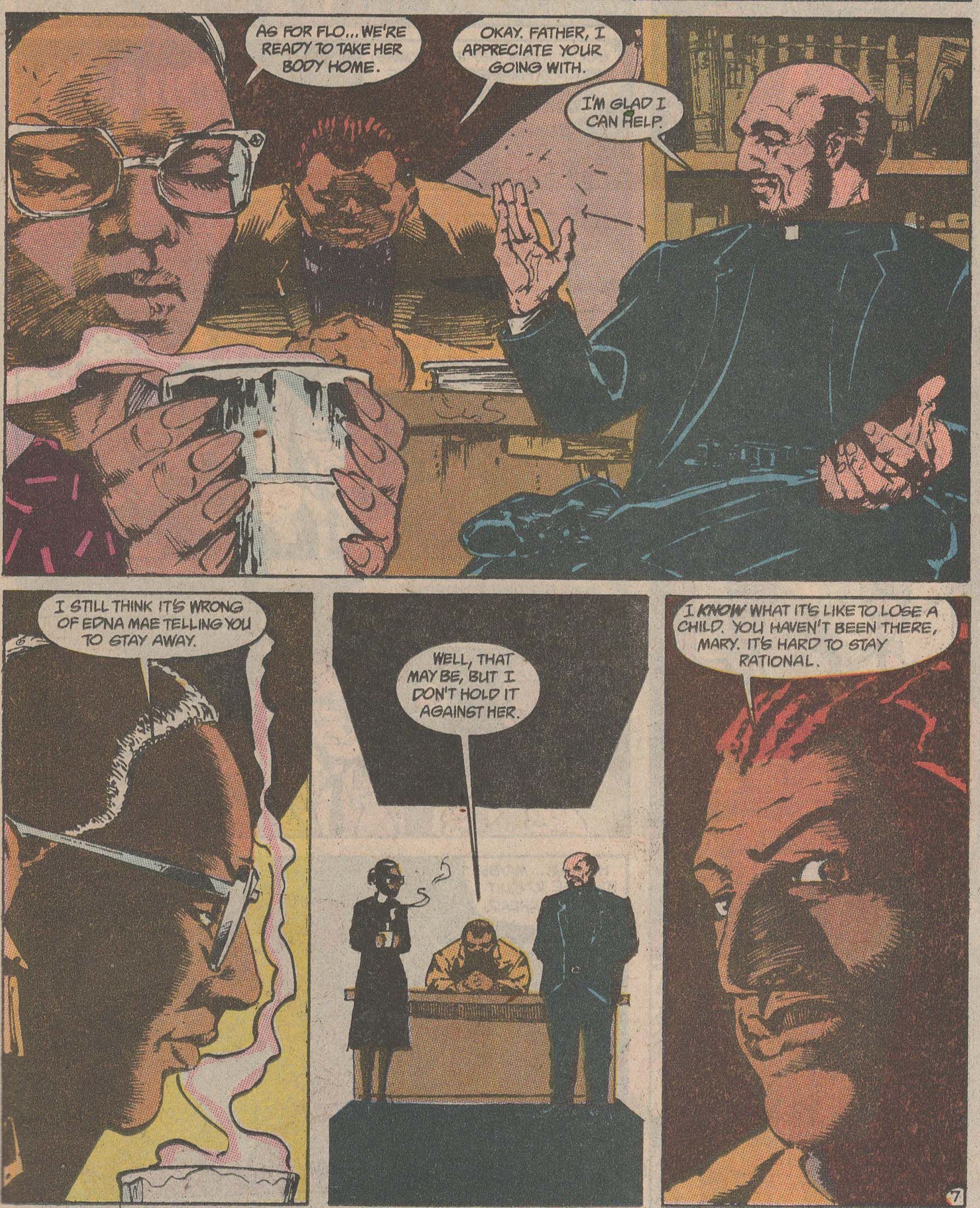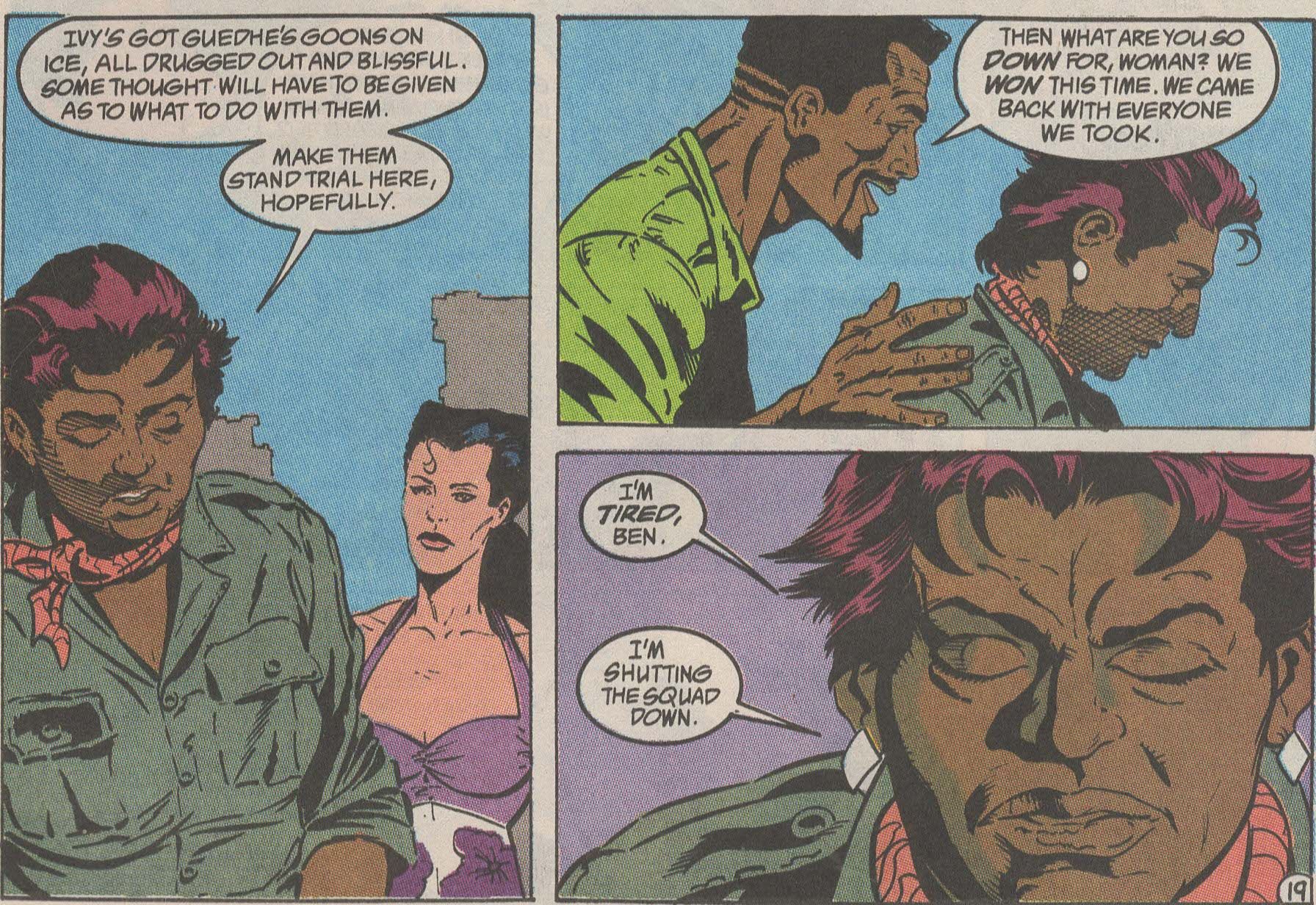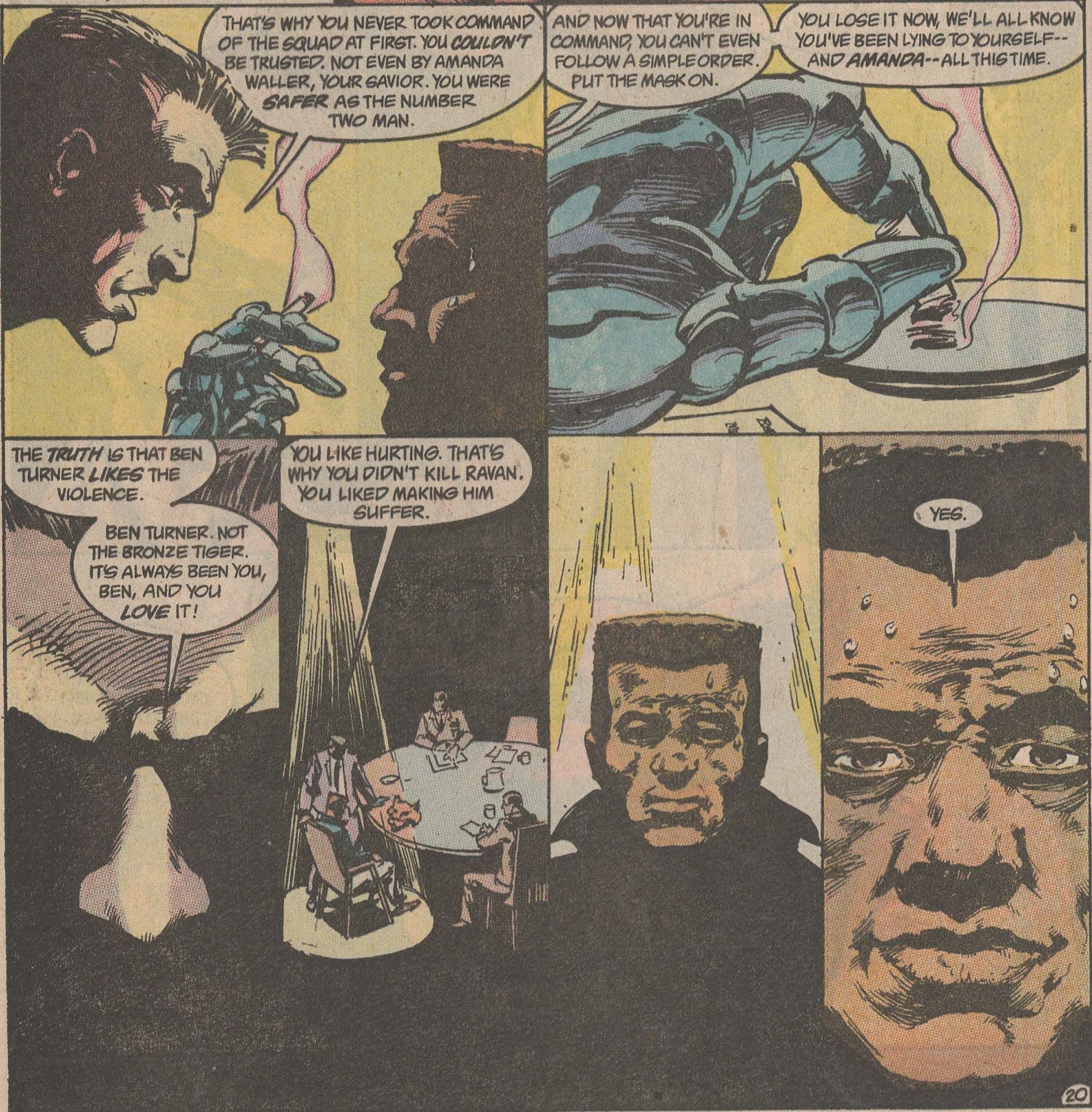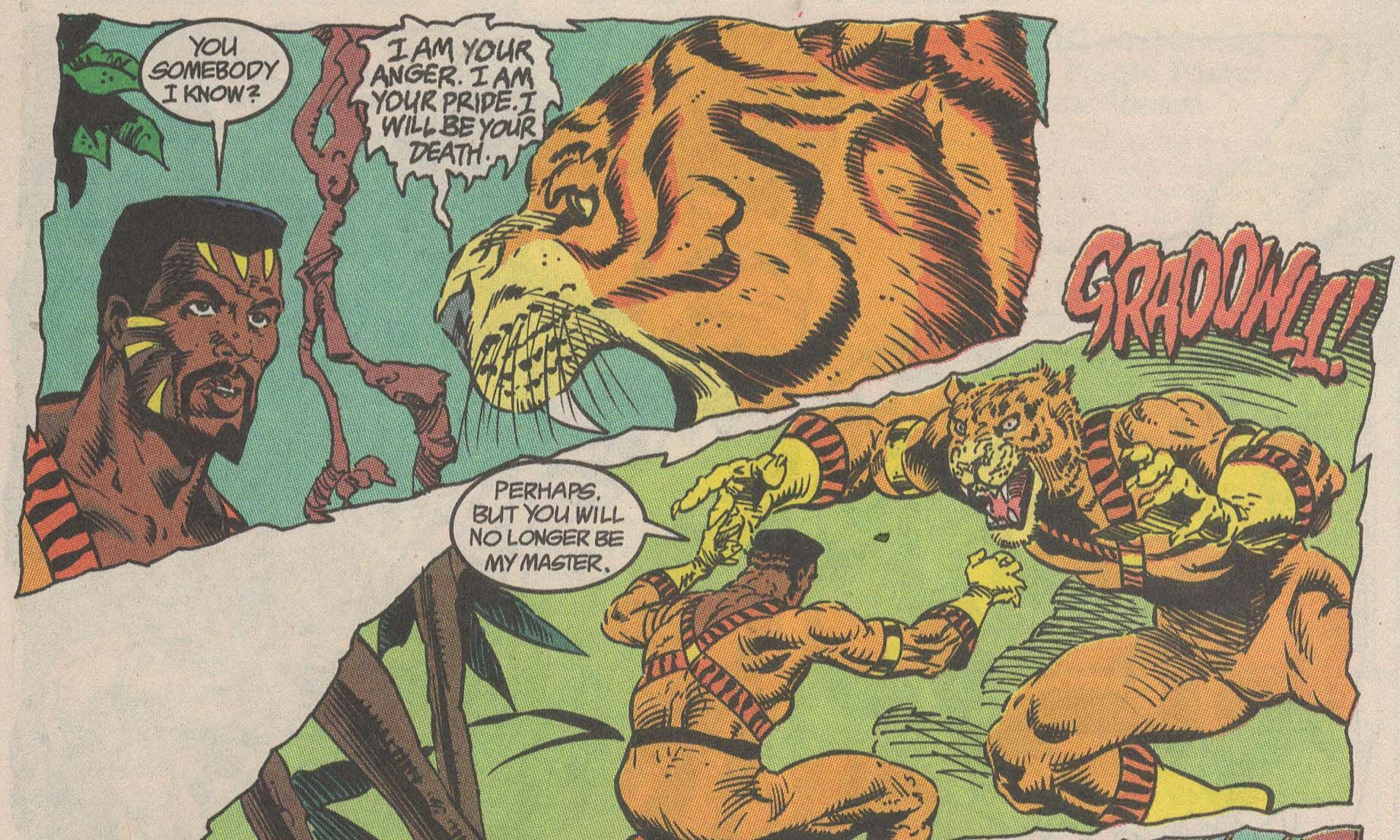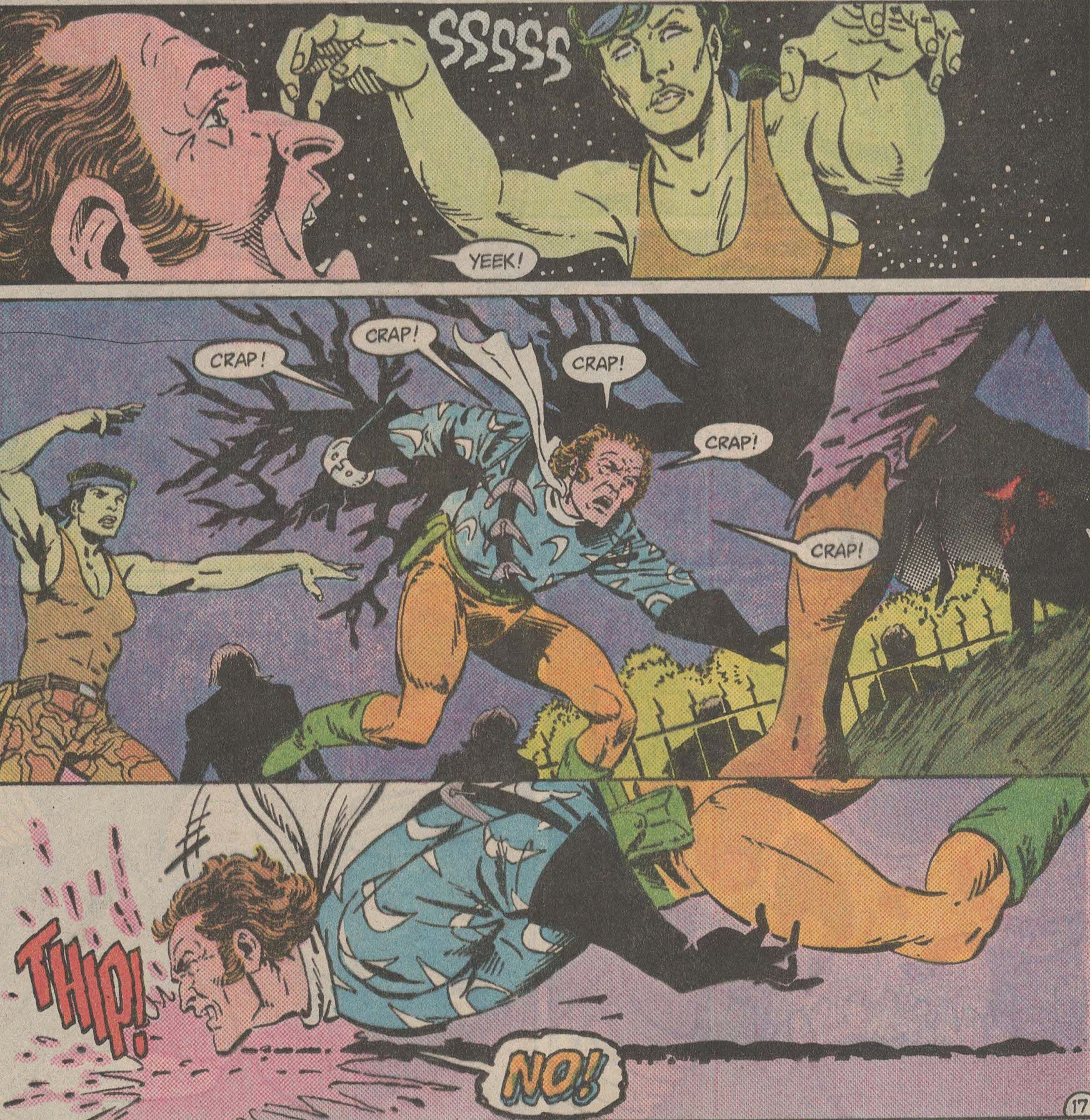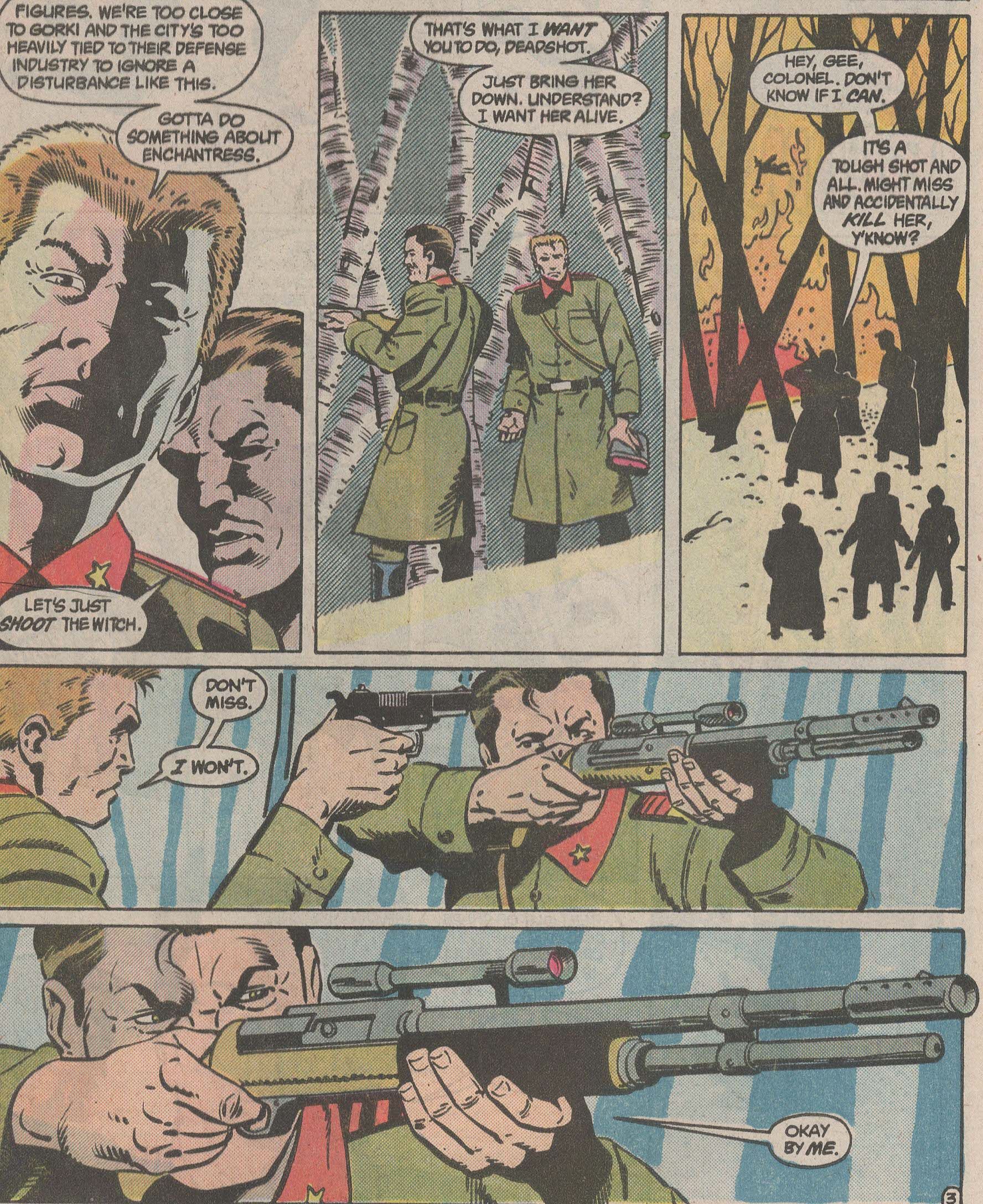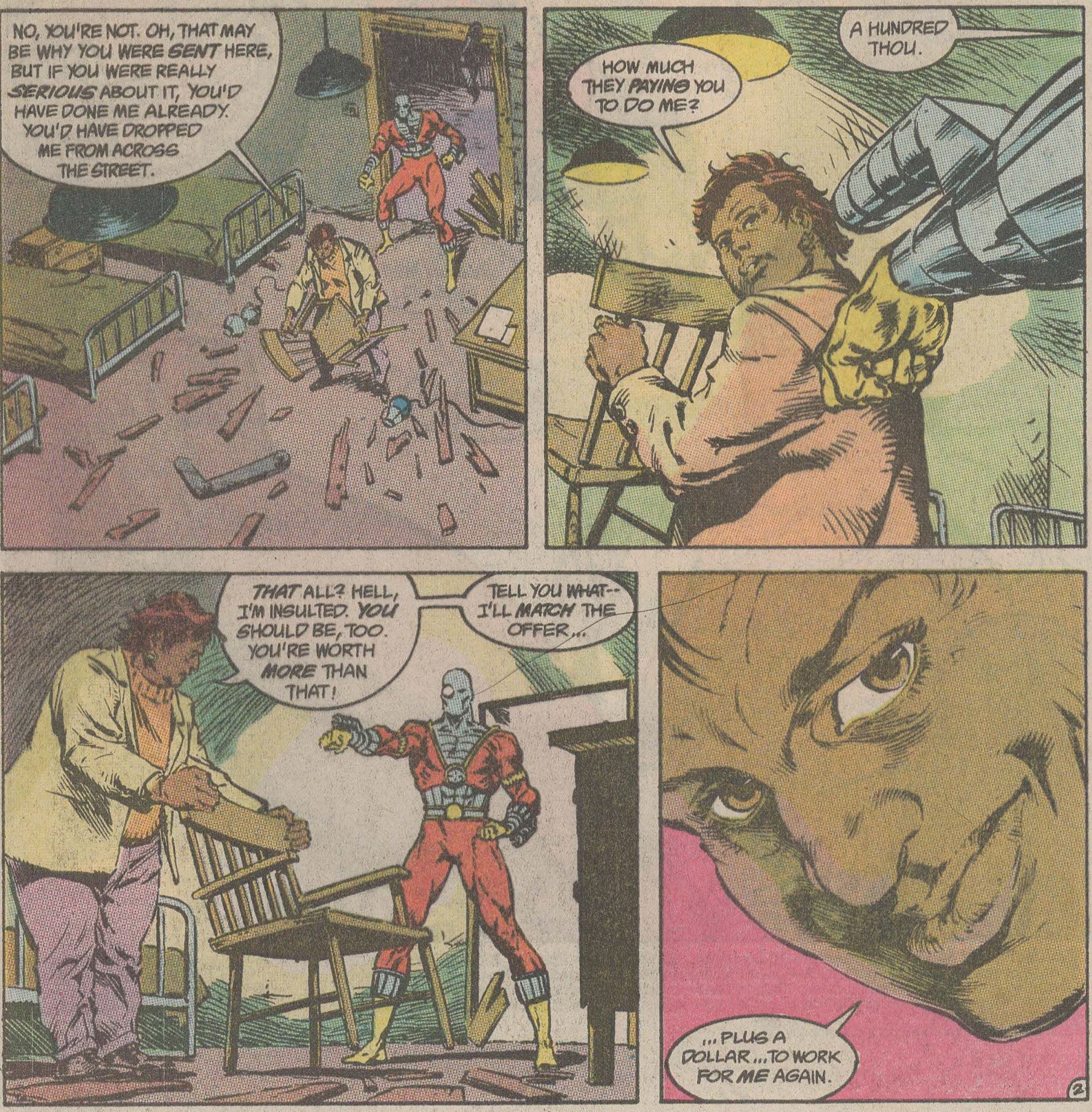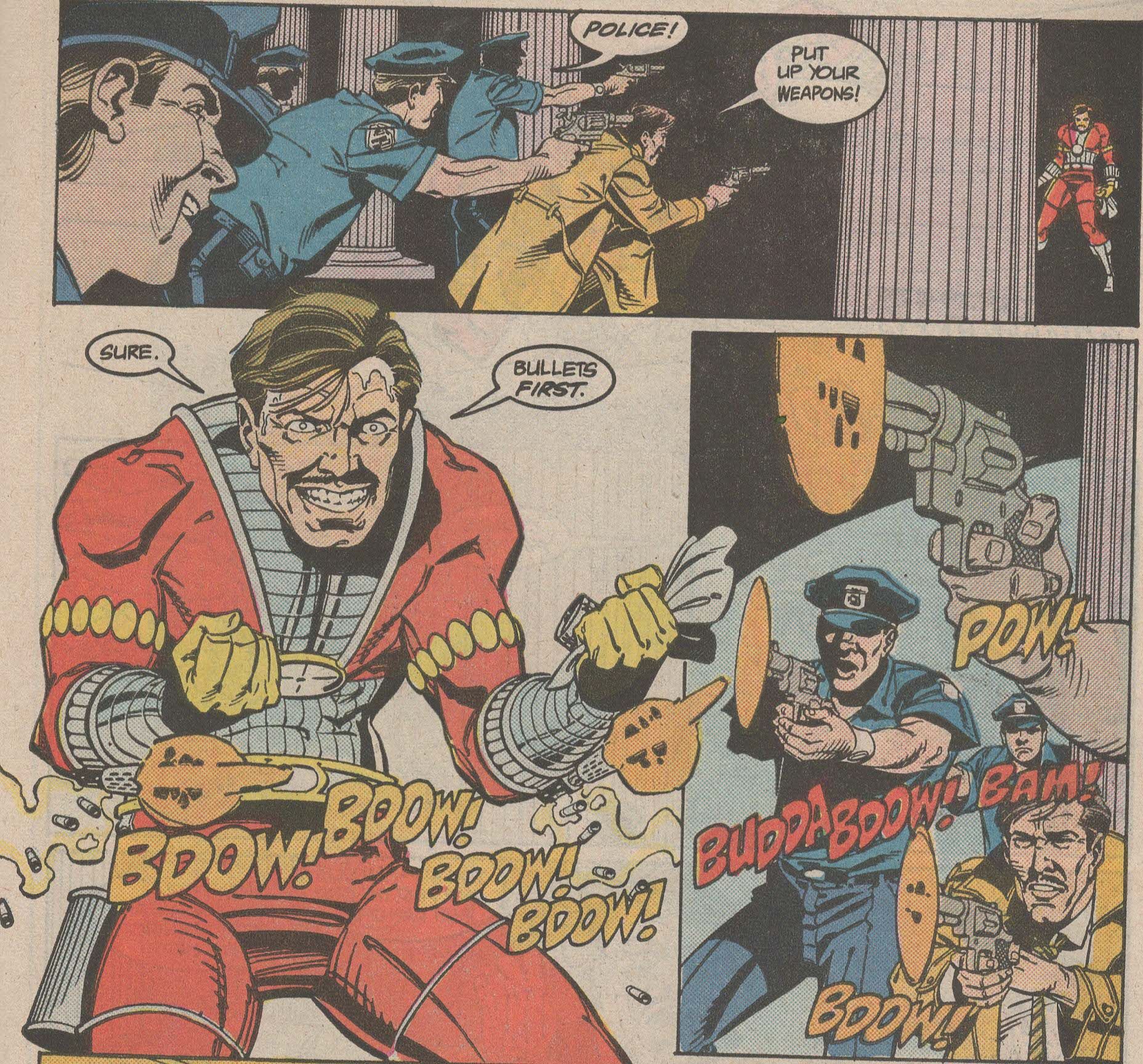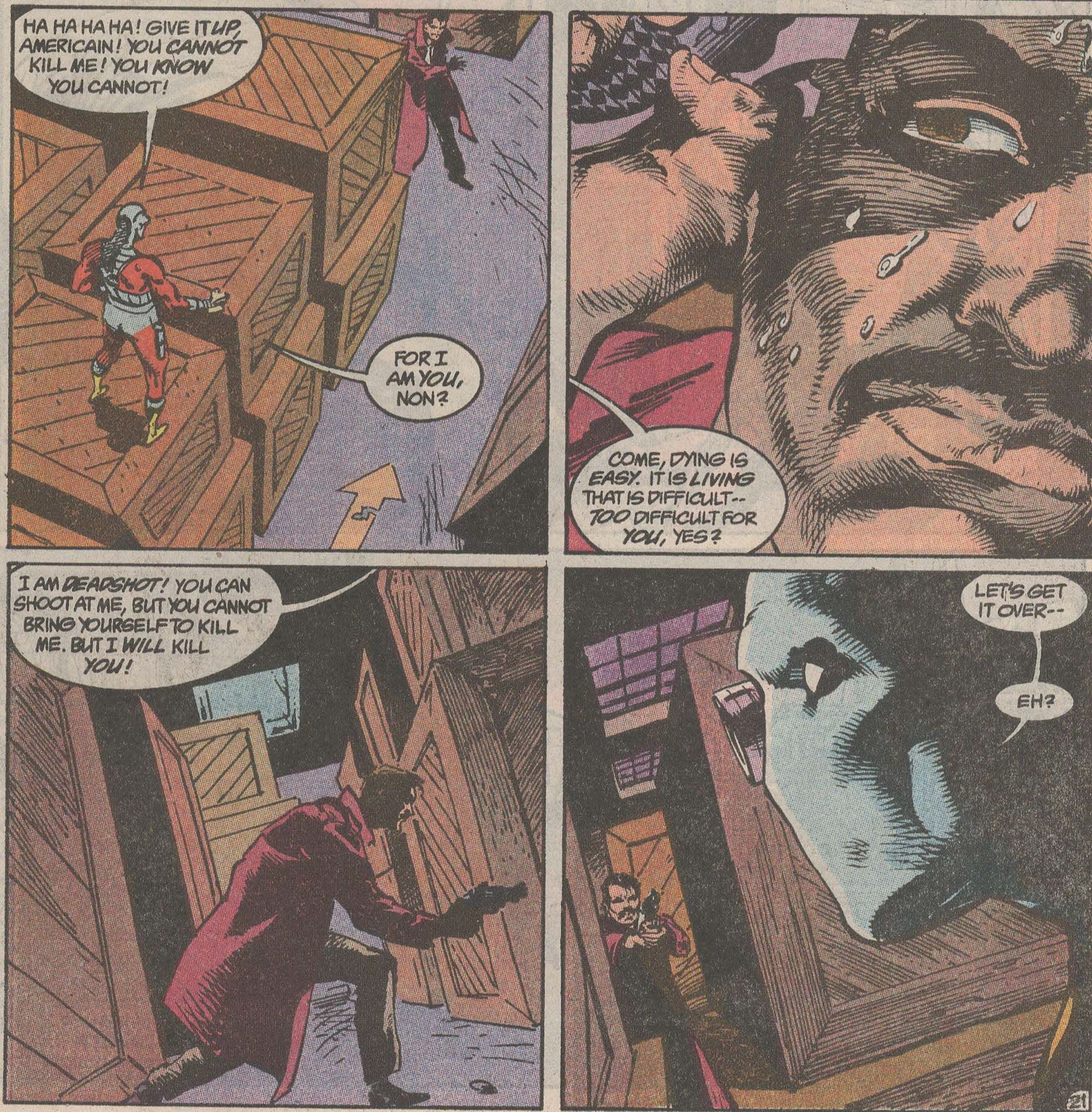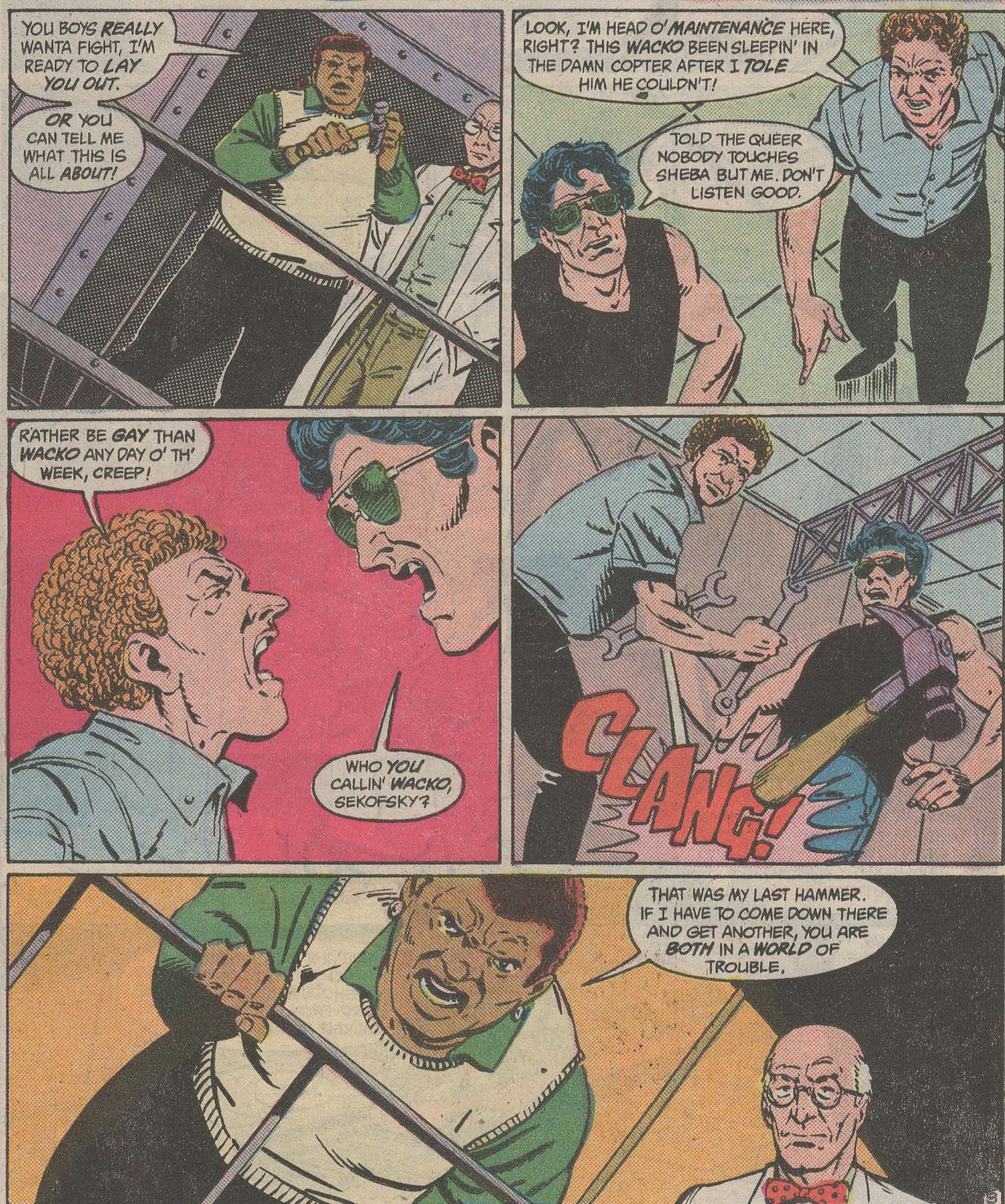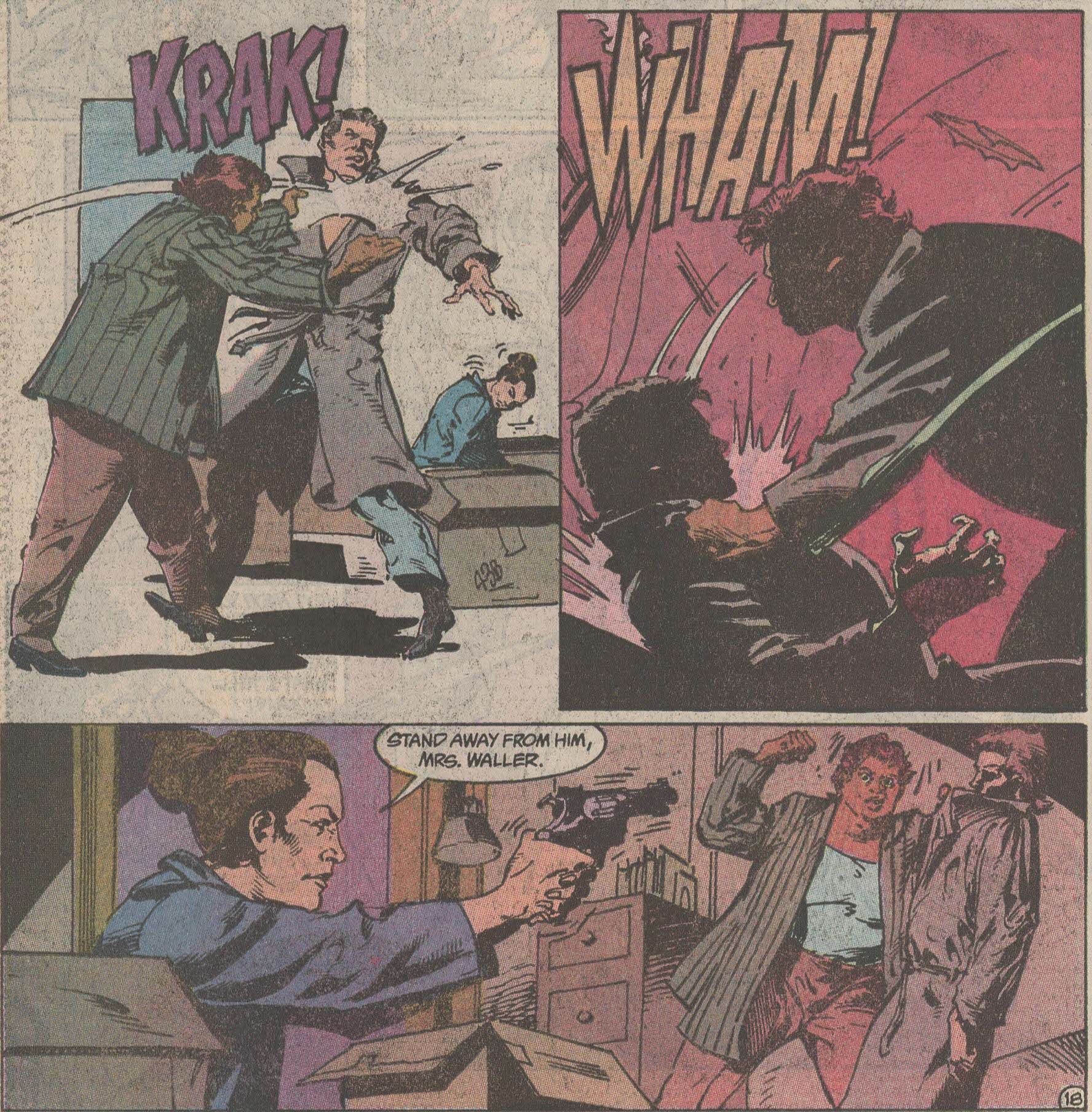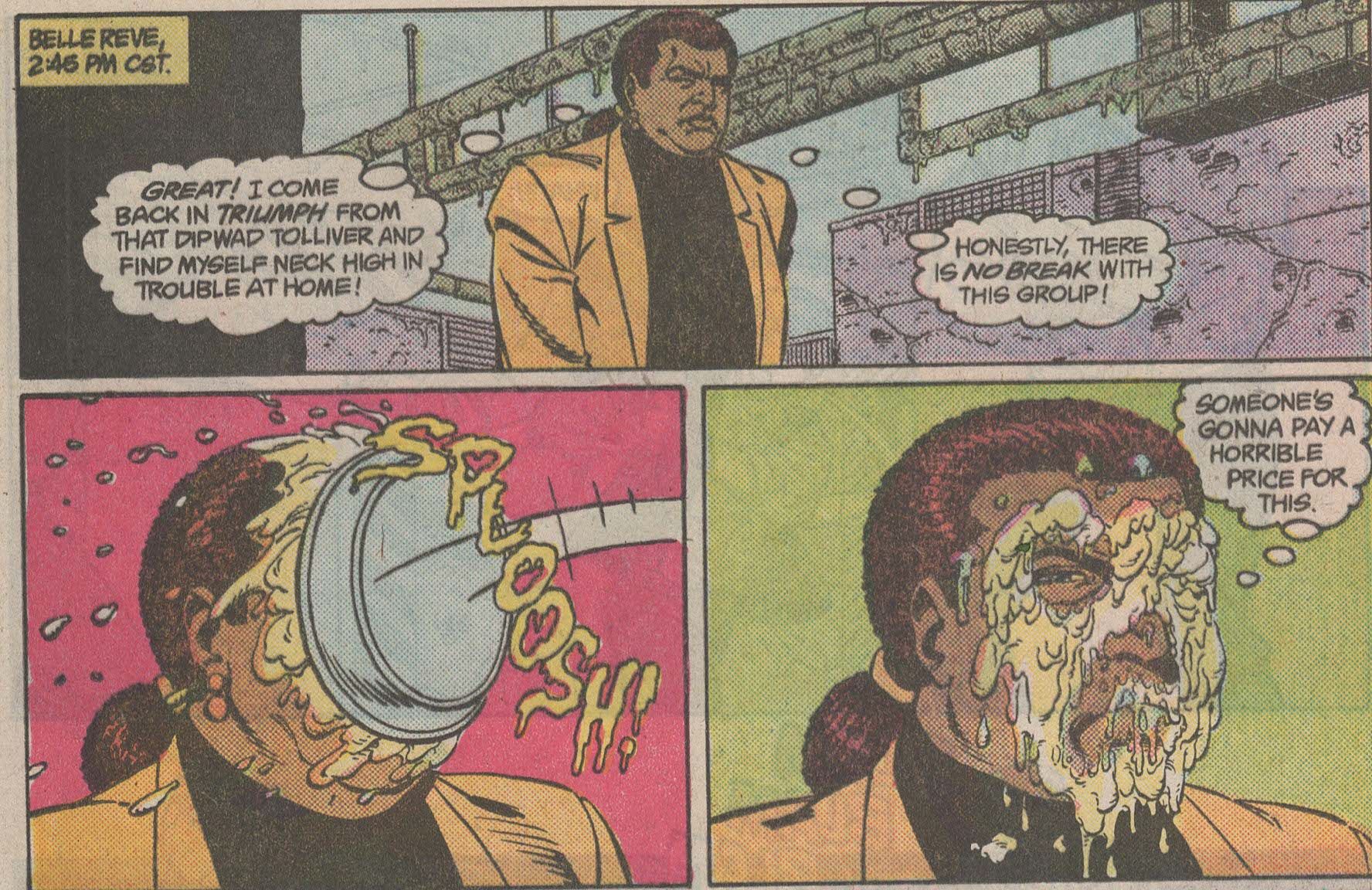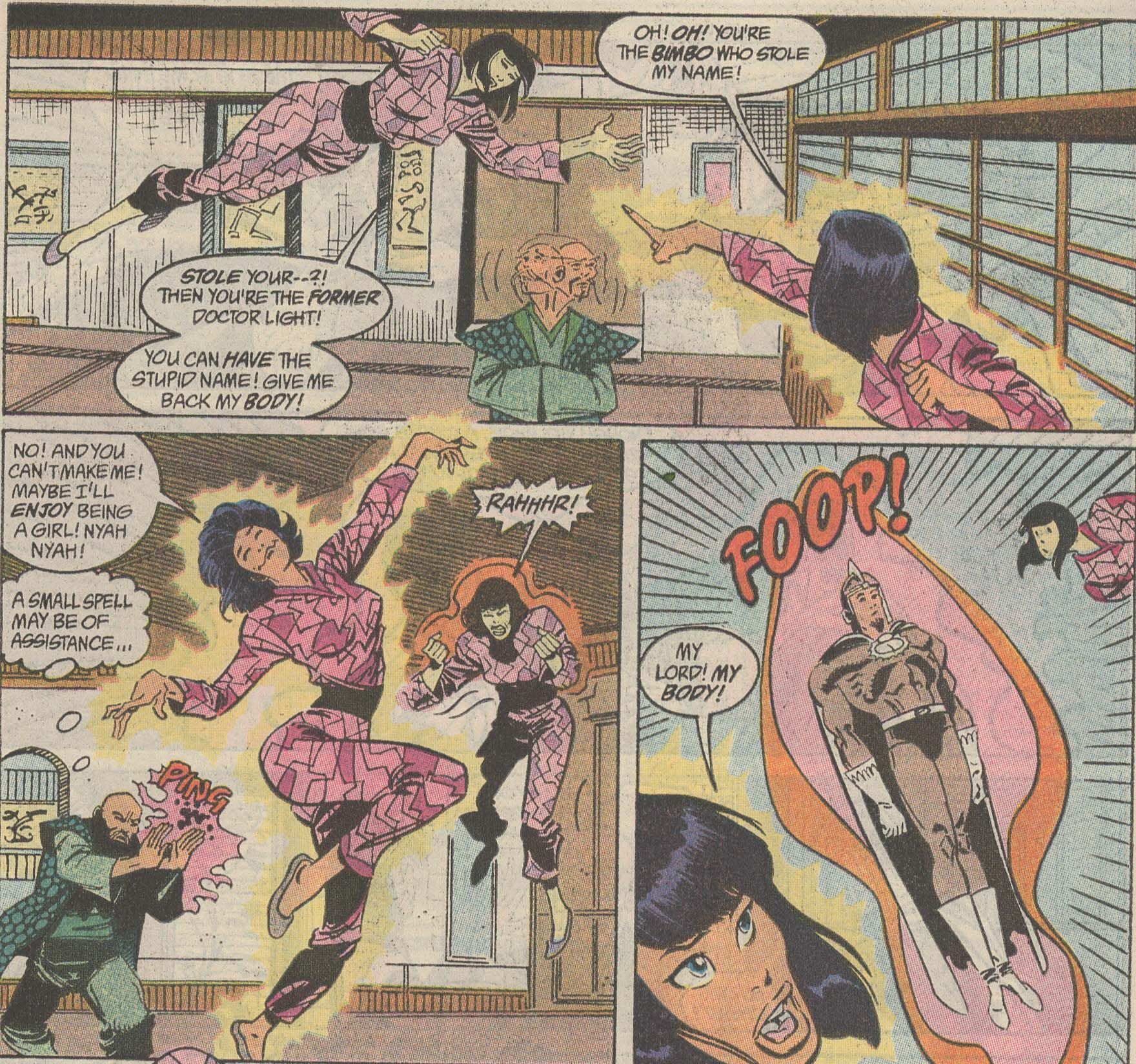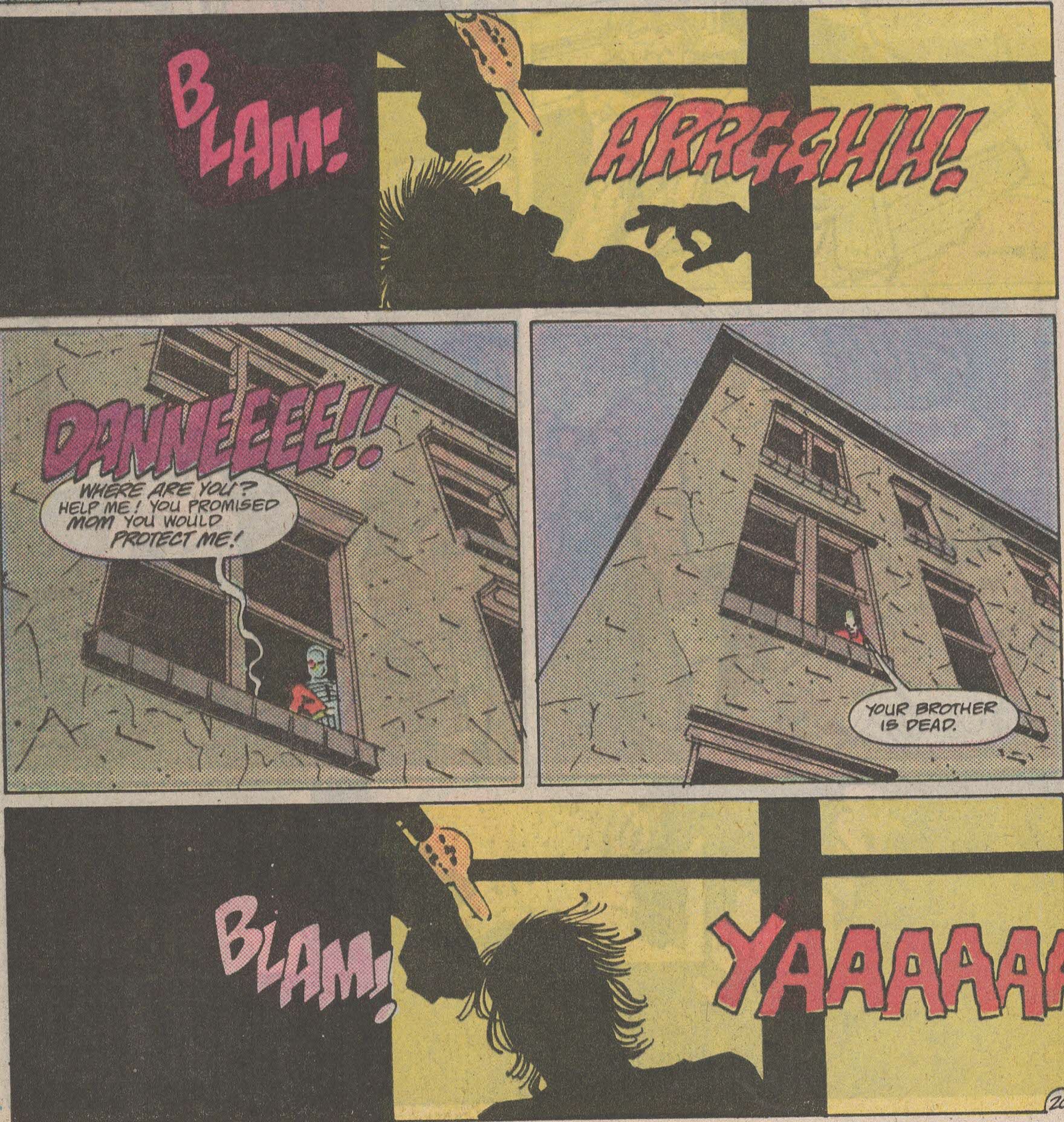You knew it was coming!
Suicide Squad by John Ostrander (writer), Kim Yale (writer, issues #23-24, 31-43, 45-66, Deadshot #1-4), Robert Greenberger (scripter, issue #38), Dan deVries (writer, issue #44), Keith Giffen (plotter/penciller, Justice League International #13), J. M. DeMatteis (scripter, JLI #13), Luke McDonnell (penciller, issues #1-24, 35, 38-39, 44, 46, 49-51; artist, Deadshot #1-4), Grant Miehm (penciller, issues #25-26, 32, 50), John K Snyder III (penciller, issues 27-31, 33-34, 36-37; inker, issue #31), Geof Isherwood (penciller, issues #40-43, 45, 47-48, 50, 53-66; inker, issues #33-41, 43, 45-51), Jim Fern (penciller, issue #52), Karl Kesel (inker, issues #1-3, 21-26, 28, 30, 50), Bob Lewis (inker, issues #4-15, 17-20), Malcolm Jones III (inker, issue #16), Pablo Marcos (inker, issues #27, 29), K. S. Wilson (inker, issue #32), Kevin Phillips (inker, issue #32), Mark Badger (inker, issue #42), Bob Campanella (inker, issues #52-66), Tom Mandrake (inker, issue #56), Andrew Pepoy (inker, issues #63-64), Al Gordon (inker, JLI #13), Carl Gafford (colorist, issues #1-8, 11-46), Julianna Ferriter (colorist, issues #9-10, Deadshot #1-4), Tom McCraw (colorist, issues #47-66), Gene D'Angelo (colorist, JLI #13), Todd Klein (letterer, issues #1-55, 57-66), John Costanza (letterer, issues #9, 56), John Workman (letterer, issue #36), Tim Harkins (letterer, Deadshot #1-4), and Bob Lappan (letterer, JLI #13).
Published by DC, 71 issues (issues #1-66 of the ongoing series, Justice League International #13, which comes after issue #12, and Deadshot #1-4, which begins after issue #18 and runs concurrently for four months), cover dated May 1987 - June 1992.
SPOILERS, of course!
Suicide Squad is a sneaky-great series, as if you pull out a random issue, it will probably be good-to-very good, but probably not a great single issue experience. John Ostrander (joined by his wife, Kim Yale, for much of the run) creates such vivid characters and cool moments that when you look at the run in toto, it's a classic.
Part of this has to do with the art, which is never superb but never bad, either. Part of it is just the nature of the comic - Ostrander works with a large cast of villains and morally ambiguous good guys, so there's a lot of shades of gray in the comic that lead to stories that often don't have clean-cut endings, much less happy ones. This kind of comic takes the long view, and by the end, it's a marvelous collection of comics that form a brilliant story about villainy, the willingness to sell your soul for the greater good, and sacrifice. When DC started advertising that their comics weren't for kids anymore, they could have used this one as a poster child.
Suicide Squad came out in the flush of creativity that marked post-Crisis DC (and lasted for almost 20 years), when the company was willing to throw a lot of stuff at the wall to see what would stick. Ostrander, coming from GrimJack, began an amazing run of DC comics that included Firestorm, The Spectre, Hawkworld, and Martian Manhunter. Suicide Squad was the first of those (Ostrander's run on Firestorm actually beat this to the stands by a month, but Ostrander had been working on Suicide Squad for a longer time), and it shows everything he was capable of, beginning with the morally conflicted character at the center of the book.
Amanda Waller is one of the best creations in comics over the past 30 years, and Ostrander made her into someone capable of backing down Batman and made readers believe she could, no mean feat. Waller is special for a few reasons: She's a woman, she's black, she's large, and she has no superpowers. All of these made her an anomaly in superhero comics of the 1980s, and unfortunately, she would still be one in today's comics (if DC hadn't made her thin and hot in the 2011 Reboot). As the leader of the Squad, she's the figurative wall for them, too - a wall between the contentious characters she has to corral, and wall between the Squad and the U.S. government, a wall between the Squad and Checkmate (another division of Task Force X, under which the Squad falls), a wall between Batman and other superheroes and the truth about what she's doing. In issue #31, we learn a bit about her back story and her rise from poverty and her learning about self-reliance, but Waller takes it too far, and builds a wall around herself so she isn't crippled by the pain of sending people off to die (even if they are criminals). Throughout the series, Ostrander shows that she is human, and she develops many cracks in the wall, although she never breaks completely.
She cares even about the villains on her team, to the extent that she won't send them on obvious suicide missions (despite the name of the team, she does want them to return alive even though they're expendable). She acts tough with the heroes on the team, but that's only because she sees the big picture that they often miss. When Nemesis (Tom Tresser) gets captured in the Soviet Union in issue #7, Waller doesn't do anything to help him because he knew the risks. In Justice League International #13, the Russians publicly announce that they're going to execute Nemesis, which spurs Rick Flag - the leader of the Squad - into action against Waller's orders. Both Waller and Flag know it's a trap, but Flag is playing at being a hero, while Waller is playing realpolitik, and she knows that if the Squad goes to Moscow, they might be exposed to the world (which Waller doesn't want), while Flag thinks that you don't leave a man behind. Waller doesn't want to make the call, especially because Tresser is an actual hero and not one of the criminals she uses on the Squad, but she knows she has to. In issue #36, her cousin's daughter, Flo, dies on Apokolips, and Ostrander shows even more of Waller's humanity, as she forbade Flo from going on missions (she was on staff at Belle Reve prison, the Squad's base of operations) and doesn't know how she's going to tell Flo's mother. Waller's cousin doesn't let Amanda attend the funeral, which Waller brushes off but still hurts.
This leads to the intense issue #39, where Waller is exposed as still running the Squad (after she agreed to step down), and she decides to take care of the Loa, a trio of New Orleans drug dealers who are turning people into zombies (Ostrander, like most fiction writers, only uses voodoo in the most stereotypical fashion). She and the nastiest members of the Squad - Deadshot, Poison Ivy, and Ravan - kill the dealers and Waller goes to prison after accepting a guilty plea. She decided to punish herself, because she kept getting away with flaunting the law but can't live with her sins anymore. Early on in the book, Simon LaGrieve, the psychiatrist at Belle Reve, makes the point that she took the anger over her husband's and son's deaths and focused it, but she uses that anger as a weapon. By issue #39, she was tired of it, and she later tells LaGrieve that she felt she had to serve her penance. Once she gets out and re-establishes the Squad as a mercenary group, she's still hard as nails, but the life still takes its toll on her. When Adam Cray - who replaced Ray Palmer as the Atom for a time - is killed, Waller tells Sarge Steel that every day, she remembers the names and faces of those who died while the Squad has been in operation. She doesn't forget, and it gnaws at her. Ostrander shows the even darker side of Waller's plans in the final story arc (issues #63-66), when two different groups converge on the island nation of Diabloverde, one to help prop up a dictator, another to kill Waller's Squad.
The first group calls itself the Suicide Squad, and they were sent by the CIA to help keep the dictator in power. The second is called Task Force X, and they're sent places to clean up messes. Waller sees both these groups as a perversion of her vision, and once her Squad takes care of both of them, she disbands the Squad and the book ends. Falling sales obviously were the reason the book ended, and perhaps Ostrander and Yale had many more stories of the Squad to tell, but it felt like they had gone as far as they could with Waller. She didn't change that much over the course of the book, but she did learn some hard lessons that forced her to look at the way she ran things differently, and it's a brilliant character arc.
The comic isn't all about Waller, of course, and Ostrander and Yale do marvelous work with dozens of characters.
The core of the group is always Bronze Tiger, Captain Boomerang, and Deadshot, all of whom are richly developed over the course of the series, but the writers never give any of the characters short shrift. Ben Turner - the Bronze Tiger - is a hero, so naturally he's not quite as interesting as the other two, but Ostrander and Yale put him through the wringer quite nicely as the series moves on. He was Waller's first choice to lead the Squad, but she was overruled and Flag was put in charge. In issue #38, King Faraday implies that the powers-that-be didn't want Waller and Turner in charge because they're both black, but Ostrander and Robert Greenberger (who scripted that issue) never go anywhere with that (Ostrander and Yale tend to shy away from racial issues in the book, which is probably smart, but that's still an intriguing road not taken). Turner was a member of the League of Assassins, but his brainwashing was broken and he began working on the side of angels. He and Mari McCabe have a romance for a while, which spurs Flo - who also digs Ben - into action on Apokolips and leads to her death. Turner can never quite escape his past - Ostrander is always very interested in examining how the past shapes the present - and in the jungle of Diabloverde, he finally accepts his role as the Bronze Tiger, absolving his younger self of the violence that he committed.
Turner is noble as he struggles with the sins he's committed, while Captain Boomerang is the complete opposite - he loves being a villain, and he never takes any chance to reform or even act the smallest bit noble. Boomerang is the comic relief of the book - this comic, for all its bleakness, can be very funny - and Ostrander and Yale have a good deal of fun with him. He's a coward and a bully, so on the first mission, when he has a chance to save Mindboggler's life, he doesn't because she insulted him earlier and because it might expose him to gunfire. He wants an apartment in New Orleans instead of staying in Belle Reve, and he takes that inch and turns it into a mile to use the Mirror Master's gear to commit crimes, figuring that he won't be suspected. This leads to a very funny issue where Waller figures out he and the Mirror Master are the same person and she puts both of "them" on the team, which of course means Boomerang spends a lot of time trying to keep up the charade. During the "Millennium" crossover, he convinces Slipknot that the bracelets Waller puts on the Squad to keep them in line (they explode if the wearer tries to escape) are bogus, just to see if Waller was bluffing.
Slipknot runs for it, blows his arm off, and Boomerang gets his answer. Boomerang throws up possibly more than any comic book character ever has during a series, as he's drunk when Turner drags him along on the mission to save Nightshade's brother, and spinning through dimensions doesn't agree with him, while later, he pretends to be Batman and vomits when Blue Trinity, a Russian speedster, wraps him up in his cape and spins him. Toward the end of the run, Boomerang goes back to Australia for his mother's funeral, and even this glimpse into his family life doesn't humanize him very much, as he discovers that he might be the product of adultery and reacts poorly to it. On the way back to rejoin the Squad, he spends too long in the airport bar and causes he and Deadshot (who went with him to the funeral) to lose their luggage ... with Deadshot's guns in it, which gives Deadshot a reason to kill him. Boomerang is refreshingly villainous - he's not a crazed sociopath like many of the other people who come and go on the squad, but he cares for no one and never reveals a hint of remorse or empathy. He loves being a villain, and while he's certainly cowardly, Deadshot does point out that if he's put in a tight spot, he'll fight like crazy to get out of it, which makes him perfect for the Squad.
Floyd Lawton - Deadshot - is probably the book's second-biggest star, after Waller.
This was his breakout book, to the extent that creating a comic like this without him these days is unthinkable (Will Smith is playing him in the movie, which seems ... weird). Deadshot, of course, was an old Batman villain from the 1950s who was given an update (and a flashy new costume) in 1977 by Steve Englehart and Marshall Rogers, but even as he became more prominent in Batman's world, he was still just a villain. Ostrander and Yale turned him into an amazingly complex character, one who has become a minor star in the DC Universe. Lawton is described as truly suicidal in issue #1 (unlike the other members of the team, who just go on suicide missions), and he spends the series proving it. When the Squad is based at Belle Reve, he lives in the prison because he doesn't care where he sleeps. He tells his psychiatrist, Marnie Herrs (who becomes a bit too emotionally attached to him), that when he wants sex, he gets a prostitute because who wants the hassle of dealing with a relationship? He interprets mission orders very literally and very finely, to the consternation of some, including Waller. When she tells the Squad to stop Rick Flag from killing a senator (Senator Cray and his aide were blackmailing Waller to help with the senator's re-election or they'd expose the Squad, which is a dirty little secret), Lawton simply kills the senator himself. Hey, at least Flag didn't do it!
When Waller hires him to shoot William Heller in issue #43, he doesn't kill him because she didn't say so. Batman, who tried to stop him from shooting Heller, asks him if he has any moral code at all, and Lawton gets perhaps the best line in the entire comic: "What for? Nobody hiring me has one."
Ostrander and Yale do a lot of work with Lawton during the series. In the first issue of his mini-series (which was a mini-series so that Ostrander and Yale didn't ignore the other characters for a few months, but it also feels like it could have been done because the mini-series is so much bleaker than the ongoing), we get a recap of his origin as the Batman wannabe who was secretly committing crimes, and the writers really run with the idea of "Batman wannabe" for Lawton. In a famous scene, when the two meet up in issue #10, Deadshot says he'll kill Batman "for the sheer pleasure of it," but Batman isn't buying it, telling Floyd that he pulls his shots when he's fighting him. This little piece of psychology is fascinating, because Lawton has never gotten over the fact that he's not a hero, and even though he hates Batman, he can't quite destroy him, either.
We learn a lot about Lawton - he grew up wealthy, of course, and he joined the Communist party and learned Russian as a way of rebelling. He has a son, who dies in the Deadshot mini-series when Lawton's mother arranges his kidnapping (I told you it was bleak!). We also learn in the mini-series that his brother, Eddie, whom everyone idolized, killed their father because their mother told him all about their father's infidelities and other sins. Floyd tried to stop Eddie but missed his arm, shooting him in the head. As Eddie was the golden boy, everyone agreed to let Floyd take the rap. These revelations drive Lawton crazier than he usually is, which leads to his assassination of the senator and his eventual confinement in Arkham Asylum. In the "no-costume" period of Suicide Squad (after Waller gets out of prison in issue #40 and turns the group into a mercenary unit, they went on missions without wearing costumes until the final story), Lawton's costume gets lost, as I noted above, and it ends up in Marseille, where, in issue #51, Lawton travels to take it back from the man now wearing it. He's told it's there by Henri Ducard, who wagers that Lawton won't be able to shoot the new wearer because the costume is so much a part of him that it would be like killing himself. Lawton, however, does kill the man, and thereby "kills" Deadshot.
Does that make him healthier? Not really, and Boomerang later tracks down the costume and gives it back to him. This idea of the power of totems is present throughout the book - Ben Turner goes through a similar ordeal with regard to his costume, and during the "War of the Gods" crossover in issue #58, Black Adam even orders the Squad to wear their costumes because "ceremonial garb has a value" when you're fighting gods and magic. For Lawton, the costume helps hide his fractured psyche. It's not too unique to say that costumed heroes (and villains) retreat inside their outfits, but Ostrander and Yale do a wonderful job showing it without calling too much attention to it. While wearing the uniform, Deadshot is unfazed by anything. In the final issue of the series, the Squad fights the magical jungle in Diabloverde, which preys on your deepest fears. In a wonderful sequence, most of the pages show the other members battling their demons, while in narrow panels along the bottom, Deadshot simply strides through the foliage. He has faced worse demons than this throughout the course of the series, and the jungle doesn't bother him at all. It's a wonderful visual shorthand to wrap up his story. At the very end of the comic, he and Count Vertigo stand on a cliff, as the count asked Deadshot to kill him if he ever felt that his depression was becoming too difficult to handle. Vertigo tells him that he wants to live, and in the final panel, the two men have disappeared. Vertigo can fly away, but Lawton couldn't, so the implication is that he plunged back into the jungle, where he could escape everything.
It's not a happy ending (Waller and Ben get those), but it is a fitting one.
The great thing about Suicide Squad is that Ostrander and Yale don't shortchange any characters. Rick Flag, the leader of the group early on, is the most heroic character, but he lives in the shadow of his father, who led the first Squad years earlier. Flag is also haunted by his own failures as mission leader, plus by the fact that he knows Waller doesn't want him as the leader. He commits his entire life to the Squad, so when he finds out that Derek Tolliver, Senator Cray's aide, is blackmailing Waller, he goes rogue. Waller had already counter-blackmailed Tolliver, but in true Waller fashion, she didn't tell anyone, so Flag decides he has to kill both Tolliver and Cray. He dispatches Tolliver, but Deadshot "saves" him from killing Cray, although Flag knows he can never go back. Being the hero, he decides to destroy the Jihad, the superpowered terrorist group that the Squad had fought twice already. Flag blames himself for letting them survive, so he goes on a suicide mission to destroy their base. If we ignore the fact that Ostrander resurrected Flag almost 20 years later (and we should), it's a brilliant end to his story, as he would never forgive himself for what he perceived as his failures and at least he was able to do some good before he went.
Ostrander creates a group of people at the prison who, while they don't get much page time, are fully-developed individuals. John Economos, Belle Reve's warden; Simon LaGrieve and Marnie Herrs, the psychiatrists; Briscoe, the helicopter pilot with his own issues (he names his helicopter after his dead daughter); and Richard Craemer, the spiritual counselor, who would play such a big role in Ostrander's next long series, The Spectre, are all fascinating characters whose fates are important to us. The many costumed characters who pass through the series are written wonderfully, too, from a whining Oswald Cobblepot to the insane Punch and Jewelee (who nevertheless have a healthy and ultimately fecund marriage). Nightshade and Nemesis aren't in the comic too much, but they still make strong impressions, and even those characters who we kind of know are marked for death immediately (Ostrander and Yale, true to the book's title, kill off a lot of characters), like Shrike, still get memorable moments. Of course, Ostrander and Yale also get credit for taking Barbara Gordon and turning her into Oracle - she makes her first "appearance" in issue #23 (as a voice on a computer), and gradually becomes more and more important in the story, culminating with her meeting with Waller when the new Thinker, Cliff Carmichael, tries to kill her.
Ostrander and Yale don't sugarcoat her disability, but they also show how she can overcome it and why she doesn't want anyone knowing about her new identity. It's amazing how many characters fit into this comic, and how different yet well written they are. It's a testament to Ostrander's and Yale's skills.
Another thing that tends to get lost in the praise for Suicide Squad (and there is praise for it, even though it's not as widespread as for some comics) is how funny it is, as I noted above. In the new millennium, DC has tended to be far less fun than Marvel, and while that's changing a bit recently, it seems like if it's a "serious" comic, there can be no fun parts in it whatsoever, and the humor has to be reserved for the less-serious books. Suicide Squad can be deadly serious (and, as I noted, the body count is fairly high), but there is plenty of room for humor. Deadshot takes himself so seriously that when he continually threatens Captain Boomerang's life after Harkness gets his luggage lost, both Boomerang and the reader emit nervous laughter, because it's difficult to know if Lawton is serious (he probably is, but who knows?). I wrote above that Captain Boomerang is a constant source of humor, but he's not the only one.
In issue #21, which features Waller blackmailing Tolliver after he blackmailed her, Eve Eden (Nightshade) yelling at Rick Flag because he holds his emotions in too much, June Moone shooting Eve because Nightshade "stole" the Enchantress persona from June, who perversely wants it back (after trying for many issues to get rid of it), and Rick Flag straight up murdering Tolliver - in other words, it's a pretty serious issue - we get ... the pie throwing. Yes, someone at Belle Reve begins throwing cream pies in characters' faces, beginning with Waller and Captain Boomerang in this issue. Ostrander and Yale continue this until issue #37 (even Lois Lane gets pied), when the culprit is revealed in a very funny scene, which comes right after the team returns from Apokolips and brings their dead comrades home. Ostrander brings Doctor Light (Arthur Light, before any sick mind conceived of him as a rapist) onto the team and uses him for comic relief. He's haunted by the ghost of Jacob Finlay, whom he accidentally killed and from whom he stole the Doctor Light costume, and he's also haunted by his defeat at the hands of Little Boy Blue and his Blue Boys (which might be the only time a "Bonus Book" inside those DC comics in the late 1980s was part of continuity).
Finlay's ghost convinces him to be a hero, which leads to very funny, yet disastrous and fatal results. This leads to issue #52, one of the odder comics in a "serious" series that you're going to find, in which the spirits of Finlay and Arthur are allowed to return to their bodies on Earth for the amusement of the devil. It's extremely wacky, and it's another example of how Ostrander and Yale didn't let the serious subject matter drag them down into a dark and depressing bog. And, of course, there's Grant Morrison's appearance and death in issue #58, which is very funny. The comic can certainly be bleak, but it's not dreary all the time.
And the comic does tackle serious subject matters, as Ostrander tends to write superhero comics that tack as close to the "real" world as superhero comics generally do. The Squad is sent on missions that would be embarrassing to the United States government if they ever got out, and even the existence of the Squad could come back to haunt the president.
Ostrander takes on all kinds of enemies - the first arc is about the Jihad, a state-sponsored terrorist unit that the Squad destroys before they can attack the U.S. The Jihad is the Squad's mirror, as they carry out missions for their government just like the Squad does - except in the case of the Jihad, the state is Qurac, one of DC's go-to Middle Eastern country. In their second appearance, in issue #17, they attack Manhattan, which in retrospect seems prescient. Not everyone in the Jihad is Muslim - they're all from places that have experienced strife, usually brought on by colonizers (one of the members is from Northern Ireland, for instance). Without being too obvious about it, Ostrander makes interesting points about the oppressed finding an outlet for their anger and what they would do with it. Ostrander sends the team to the Soviet Union early in the book to rescue a dissident, which turns out to have far-reaching consequences - Derek Tolliver told Waller about the mission without getting authorization, and when he's exposed, he decides to blackmail Waller, while Nemesis gets captured and left behind, leading to Rick Flag heading back to Russia to rescue him a few issues later. The take down a drug cartel, which leads to Mari McCabe joining the Squad for a while, as she feels that her revenge-killing of the drug kingpin means she's not worthy to do anything else except hang out with the Squad.
They get involved in the 1988 election, which leads to Flag killing Tolliver and Deadshot killing a sitting U.S. senator. Flag killed Tolliver without realizing that he had already prepared a statement about the Squad's existence, and when that gets out, Waller is hauled in front of a subcommittee to determine if she should be charged with any crimes. She gets out of that, but is forced to give up leadership of the Squad ... which she promptly ignores, and that sets up yet another complication down the line. The team gets involved in another rescue operation, this time to the African country of Ogaden, where they're confronted with the horrific specter of drought and famine. They're put in a tough spot when they have to rescue an Iranian who returns to the country and is captured by the regime; the Iranian just happens to be an ex-member of the secret police, but because he's now an American citizen, the government can't let the Iranians execute him on live television. In "The Phoenix Gambit," which runs through issue #40-43 after Waller's "year-long" imprisonment, the team heads to Vlatava (Count Vertigo's country) to intercede in its civil war, as right-wing hardliners are trying to turn back the tide of democratic reforms in the region. Ostrander does some nice work with the changing dynamic in Eastern Europe and with the United States' relationship with Russia, as even in the first Russian story arc, glasnost is transforming the area. Kobra tries to start an Arab-Israeli war in issues #45-47, and the Squad has to stop him.
And even when Ostrander brought in the DC Big Guns - Superman, Batman, and Aquaman (hey, his new series launched around this time, so we can count him!) - in what now seems like an effort to boost sales (it didn't work), he still focused on the Jihad's efforts to rescue the ex-ruler of Qurac, Hurrambi Marlo, from his American jailers. We also get a sense of the other superpowered beings in the world, as Ostrander has always been interested in creating metahumans who aren't American. The Jihad is a group of villains, of course, but we also get the Hayoth, an Israeli super-team, and we even get hints about the Mamelukes, an Egyptian super-team, and the Janissaries, who seem to be another mercenary super-team. Given the rivalry with Russia, the Red Shadows - which was basically the Soviet version of Task Force X - also feature prominently in the comic. All of these teams make the book feel more "realistic," because why wouldn't other countries have their own super-teams? In all of this, Ostrander and Yale weren't afraid to deal with all sorts of "real-world" implications of the Squad's actions, and it makes Suicide Squad both a gritty espionage comic and makes the levity necessary, as the book would be too depressing otherwise.
Obviously, as with so many superhero comics, the use and abuse of power is a main theme in this comic, and Ostrander and Yale do a fine job moving from the very macro level - the Cold War dynamic and, even more generically, the concept of "West" versus "East" - down to the very micro level, as each character attempts to gain power over their own demons and others around them.
Waller survives because she plays the game better than anyone, but even she gets worn down by it. She has an almost pathological need to hold onto power, and it takes its toll on her relationships with the other cast members - she drives Flag to kill Tolliver because she refuses to share any information, which is just another way of holding onto power, and during "The Janus Directive" (which runs for four issues of this series, #27-30, but crosses over with a few others), she doesn't reveal to anyone that Kobra's attempt to replace her with a doppelgänger has failed, so that means she has to send several characters on even more suicidal missions than usual, leading to many deaths. Occasionally, Waller's need for power serves her well, and her iron will holds the team together, but by the end of the comic, she's willing to admit that she made too many mistakes with the Squad, even though she decides to retain power in another venue, as the ruler of Diabloverde (which, as far as I know, never went anywhere, but it's an interesting path for Ostrander and Yale to put her on). All the other characters deal with power in their own ways. Deadshot, of course, struggles to have power over his costumed self, especially after the revelations about his family, the death of his son, and his assassination of Senator Cray. Ben Turner, as well, struggles with his alter ego, losing that battle for a time before he is snapped out of it. In the final issue, we see him finally gain a measure of power over the Bronze Tiger, but it's a long, difficult journey to get there.
The Duchess - who is really Lashina, a Female Fury trapped on Earth after the rescue of Glorious Godfrey in issue #3 - desperately wants to return to Apokolips to regain the power stolen from her by a rival in the group, and she doesn't care who dies for her to achieve that. June Moone wants to gain some power over the Enchantress, but she becomes addicted to that power, too, so she shoots Nightshade when Eve gains the Enchantress's abilities. Poison Ivy uses her knowledge of plants to gain control over many men, most notably Count Vertigo, who swears revenge against her. While most superhero books are concerned with the macro-level of power, it's interesting that Ostrander uses the villain dynamic to explore how people try to gain leverage over others in their regular lives. Superheroes are a bit too noble for these kinds of machinations, but because most of the Squad are either villains or damaged heroes, Ostrander and Yale can do this kind of thing very well.
For all of this, Ostrander and Yale were assisted by solid but unspectacular artists.
Luke McDonnell did decent work on the book, but his figure work is a bit stiff for such an action-packed comic, although when he's inked by the amazing Karl Kesel, his work looks better. McDonnell actually does a better job on the Deadshot mini-series, when he inks himself - it's still a bit too stiff, but McDonnell uses blacks better (which suits the bleak subject matter) and his faces have more personality. John K. Snyder III, whose art I love, was the wrong fit for the book - his blocky, Art Deco style doesn't work very well on a superhero book, but he only did full art on one issue, and his layouts on "The Janus Directive" (with Pablo Marcos and Kesel finishing) aren't bad. Geof Isherwood, the other main artist on the comic, is similar to McDonnell - his style is a bit more fluid and his inker, Robert Campanella, tended to spot more blacks (keeping with the greater emphasis on espionage in the book's final incarnation), but his art doesn't make too big an impression. The book is often fairly crowded, and the artists often have some issues with storytelling, which is too bad. For such a violent comic, the book was often bloodless, which isn't too bad - gore doesn't necessarily mean good - but it also means that occasionally it's hard to tell what happens to characters, like Flo, who dies completely off-panel (the comic lost the CCA seal with issue #35, but it didn't get appreciably more bloody). I mean, I don't necessarily want to see vomit, but when a joke involves Captain Boomerang hurling and we don't see anything coming out of his mouth, it's kind of hard to appreciate the humor.
The art in the comic is not bad at all, but it's not what you think of when you think of Suicide Squad. While Ostrander's next long-form masterpiece for DC, The Spectre, is definitely not just an Ostrander comic, but an Ostrander/Tom Mandrake comic, Suicide Squad is definitely Ostrander and Yale's comic, with the artists doing a decent job, but not the reason you read the book.
There has been one trade paperback of Suicide Squad, which will be re-released in September. With the new movie coming out, perhaps DC is committed to collecting the entire series (another collection is scheduled for February, but who knows). I imagine the individual back issues either will be or are already hard to find or pricey, given the movie, which is too bad and makes me hope even more that DC actually collects this series. It's a marvelous comic, with so much going on that it's worth many re-reads. Ostrander and Yale delve into DC history very well, but they also keep the book remarkably accessible. I know that I tend to like espionage comics quite a bit, and if you don't, you might think this isn't for you, but it's so much more than just that, and it's just a great read.
Next: Gosh, I'm still not out of the letter "S"! Will the great "S" titles ever end?!?!?!? And don't forget to take a look at the archives for more groovy comics!





